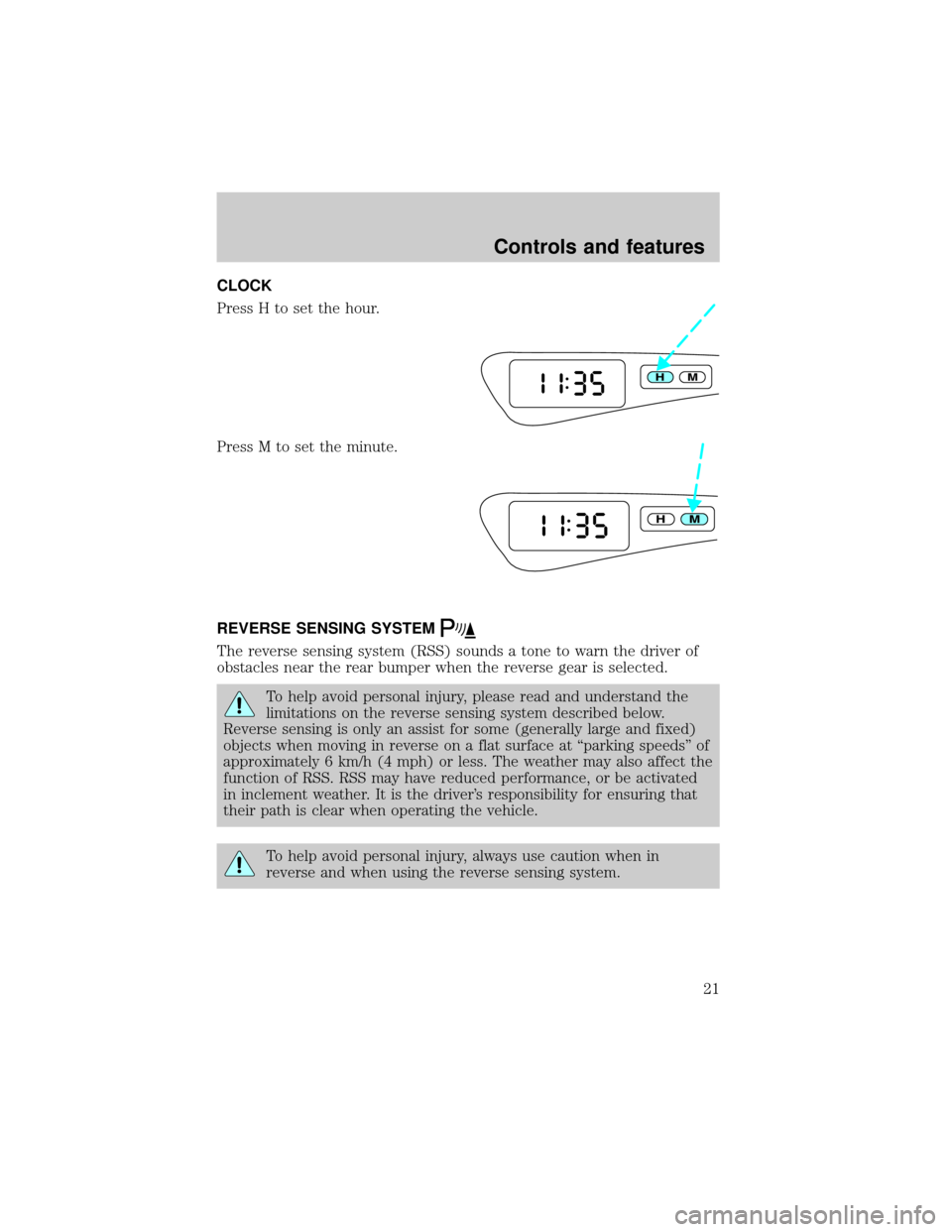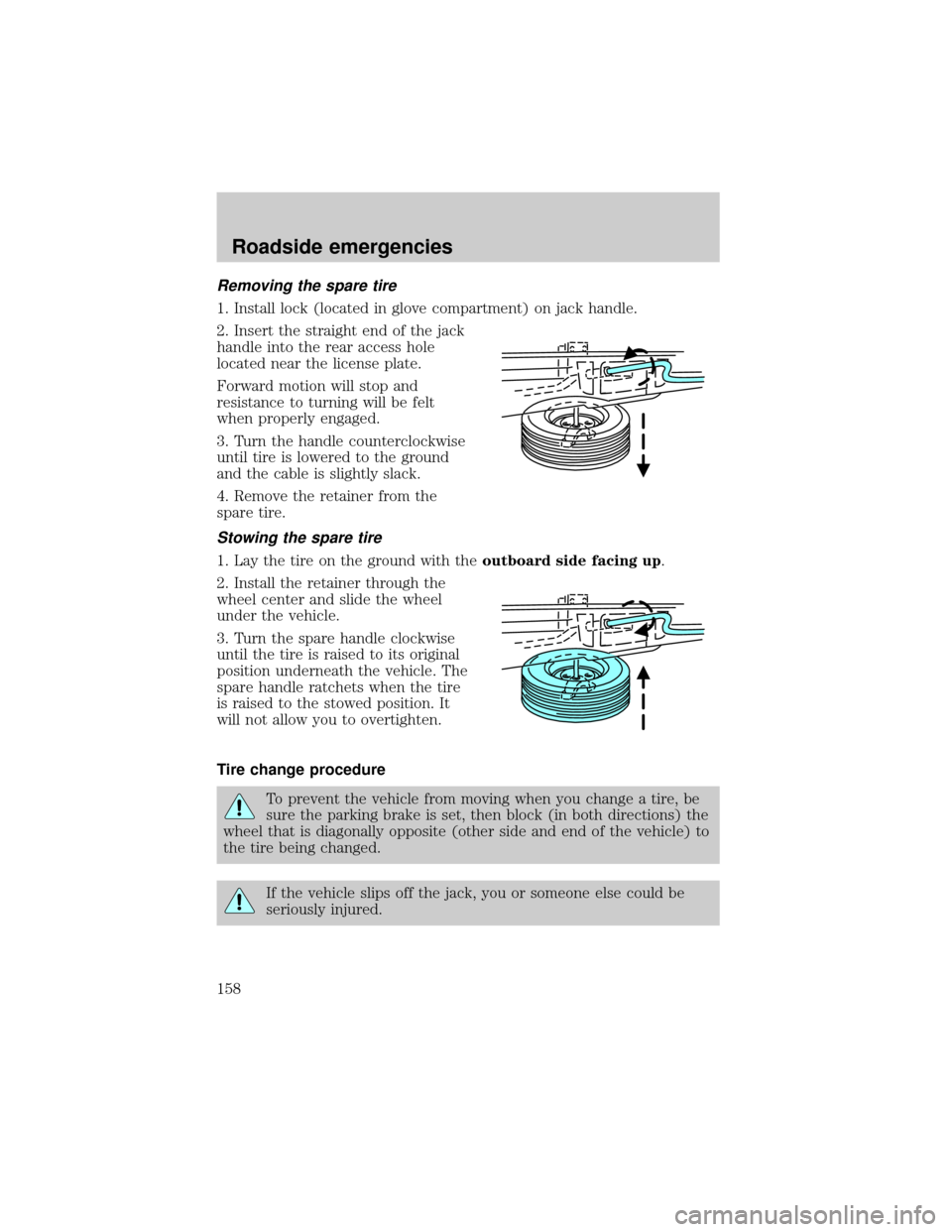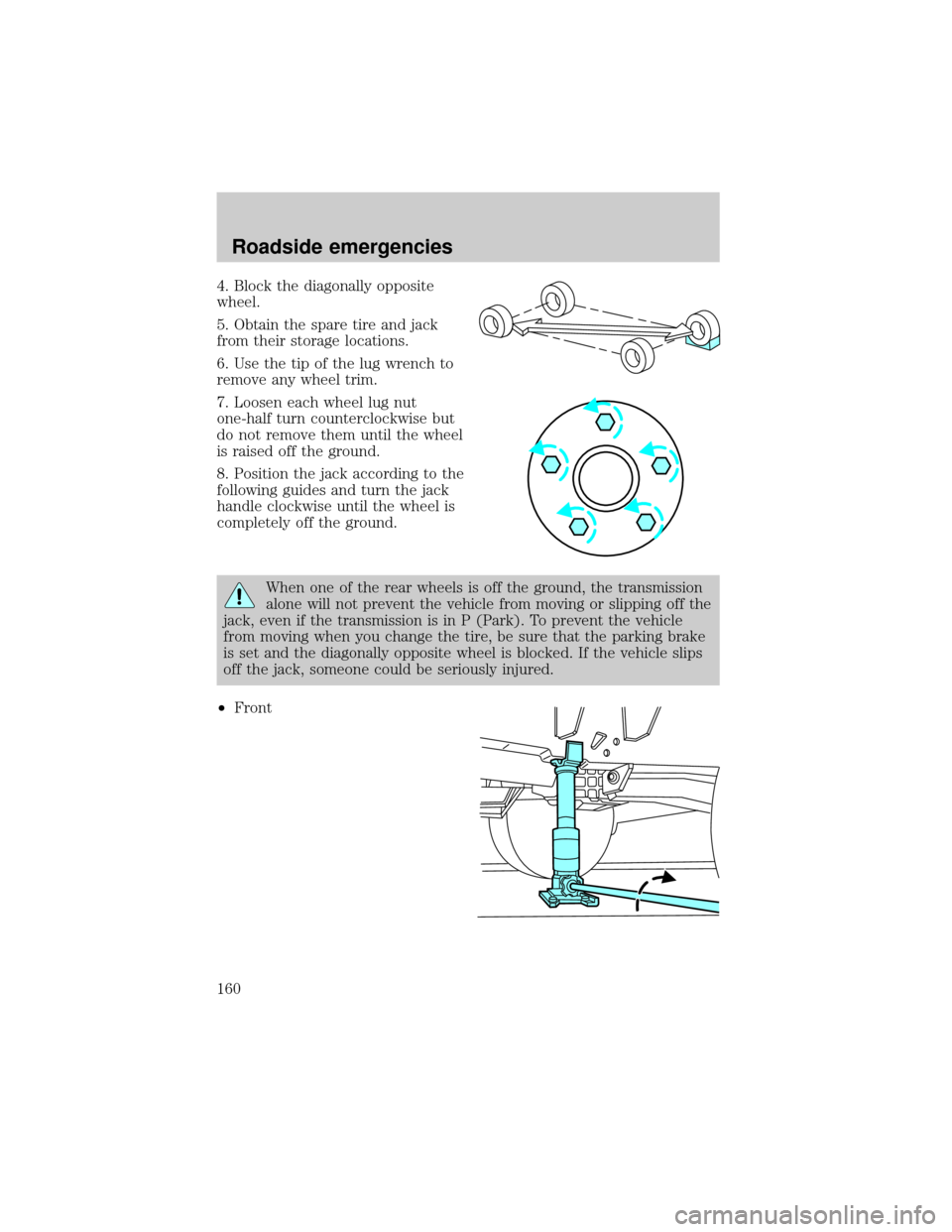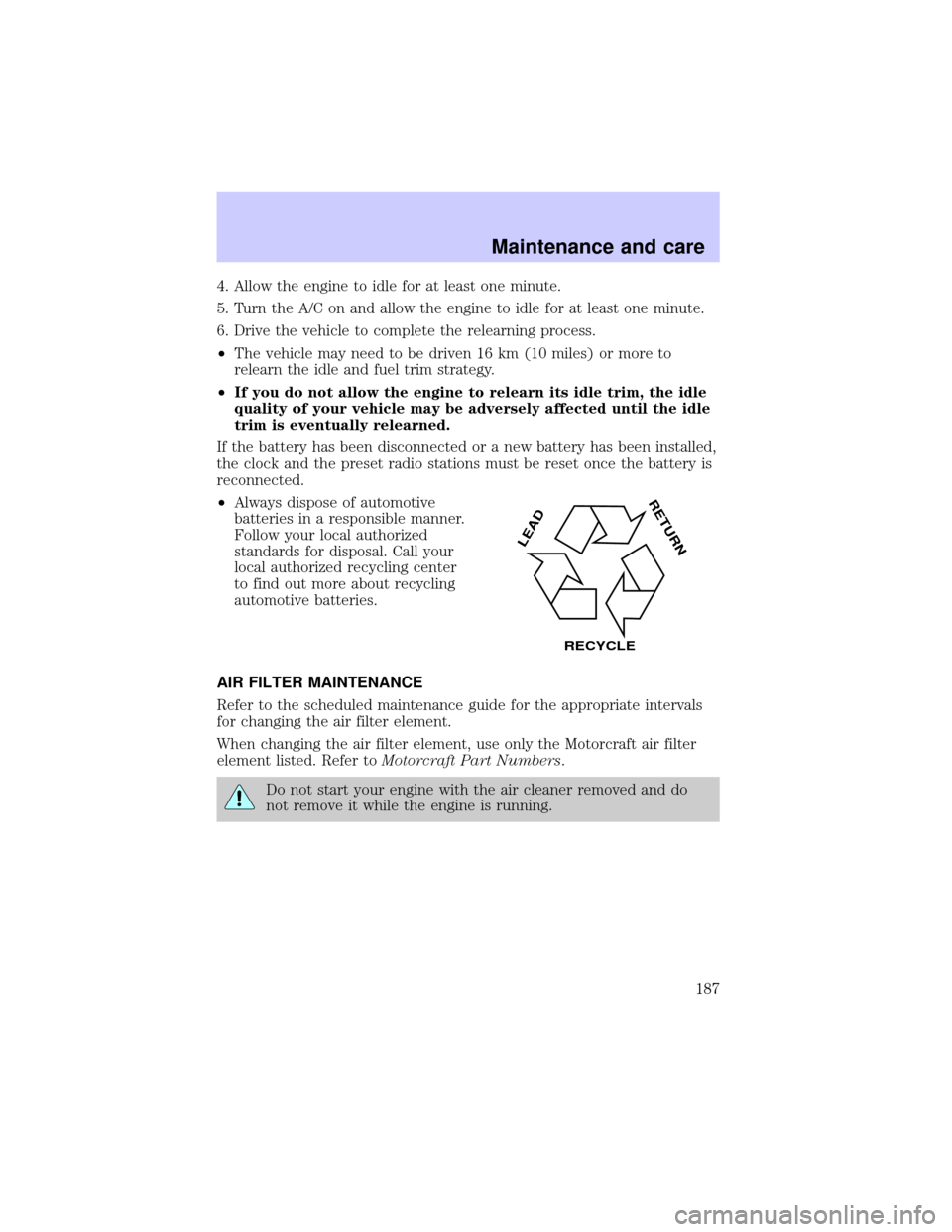2002 LINCOLN BLACKWOOD set clock
[x] Cancel search: set clockPage 21 of 248

CLOCK
Press H to set the hour.
Press M to set the minute.
REVERSE SENSING SYSTEM
The reverse sensing system (RSS) sounds a tone to warn the driver of
obstacles near the rear bumper when the reverse gear is selected.
To help avoid personal injury, please read and understand the
limitations on the reverse sensing system described below.
Reverse sensing is only an assist for some (generally large and fixed)
objects when moving in reverse on a flat surface at ªparking speedsº of
approximately 6 km/h (4 mph) or less. The weather may also affect the
function of RSS. RSS may have reduced performance, or be activated
in inclement weather. It is the driver's responsibility for ensuring that
their path is clear when operating the vehicle.
To help avoid personal injury, always use caution when in
reverse and when using the reverse sensing system.
Controls and features
21
Page 31 of 248

Shuffle feature
The shuffle feature operates in CD
mode and plays all tracks on the
current disc in random order. If
equipped with the CD changer, the
shuffle feature continues to the next
disc after all tracks are played.
Press the SHUFFLE control to start this feature. Random order play will
continue until the SHUFFLE control is pressed again.
Setting the clock
Your vehicle is equipped with a separate instrument panel mounted
clock. Please refer toClockin this chapter for instructions on setting the
clock.
Radio data system (RDS) feature
This feature allows your audio
system to receive text information
from RDS-equipped FM radio
stations.
Press the RDS control until the display reads RDS OFF. Press the SEL
control to engage this feature (RDS ON). Once the RDS feauture is on,
press the RDS control to scroll through the following selections:
Traffic
²Press the RDS control until
TRAFFIC is displayed.
²Use the SEL control to select ON
or OFF. With the feature on, use
the SEEK or SCAN control to
find a radio station broadcasting a
traffic report (if it is broadcasting
RDS data).
Traffic information is not available in
most US markets.
SHUFF
6
RDS
RDS
SEL
Controls and features
31
Page 158 of 248

Removing the spare tire
1. Install lock (located in glove compartment) on jack handle.
2. Insert the straight end of the jack
handle into the rear access hole
located near the license plate.
Forward motion will stop and
resistance to turning will be felt
when properly engaged.
3. Turn the handle counterclockwise
until tire is lowered to the ground
and the cable is slightly slack.
4. Remove the retainer from the
spare tire.
Stowing the spare tire
1. Lay the tire on the ground with theoutboard side facing up.
2. Install the retainer through the
wheel center and slide the wheel
under the vehicle.
3. Turn the spare handle clockwise
until the tire is raised to its original
position underneath the vehicle. The
spare handle ratchets when the tire
is raised to the stowed position. It
will not allow you to overtighten.
Tire change procedure
To prevent the vehicle from moving when you change a tire, be
sure the parking brake is set, then block (in both directions) the
wheel that is diagonally opposite (other side and end of the vehicle) to
the tire being changed.
If the vehicle slips off the jack, you or someone else could be
seriously injured.
Roadside emergencies
158
Page 160 of 248

4. Block the diagonally opposite
wheel.
5. Obtain the spare tire and jack
from their storage locations.
6. Use the tip of the lug wrench to
remove any wheel trim.
7. Loosen each wheel lug nut
one-half turn counterclockwise but
do not remove them until the wheel
is raised off the ground.
8. Position the jack according to the
following guides and turn the jack
handle clockwise until the wheel is
completely off the ground.
When one of the rear wheels is off the ground, the transmission
alone will not prevent the vehicle from moving or slipping off the
jack, even if the transmission is in P (Park). To prevent the vehicle
from moving when you change the tire, be sure that the parking brake
is set and the diagonally opposite wheel is blocked. If the vehicle slips
off the jack, someone could be seriously injured.
²Front
Roadside emergencies
160
Page 187 of 248

4. Allow the engine to idle for at least one minute.
5. Turn the A/C on and allow the engine to idle for at least one minute.
6. Drive the vehicle to complete the relearning process.
²The vehicle may need to be driven 16 km (10 miles) or more to
relearn the idle and fuel trim strategy.
²If you do not allow the engine to relearn its idle trim, the idle
quality of your vehicle may be adversely affected until the idle
trim is eventually relearned.
If the battery has been disconnected or a new battery has been installed,
the clock and the preset radio stations must be reset once the battery is
reconnected.
²Always dispose of automotive
batteries in a responsible manner.
Follow your local authorized
standards for disposal. Call your
local authorized recycling center
to find out more about recycling
automotive batteries.
AIR FILTER MAINTENANCE
Refer to the scheduled maintenance guide for the appropriate intervals
for changing the air filter element.
When changing the air filter element, use only the Motorcraft air filter
element listed. Refer toMotorcraft Part Numbers.
Do not start your engine with the air cleaner removed and do
not remove it while the engine is running.
LEAD
RETURN
RECYCLE
Maintenance and care
187
Page 239 of 248

in rear seat ..............................119
Cleaning your vehicle ...............212
exterior ....................................212
instrument cluster lens ..........216
instrument panel ....................216
interior .....................................216
plastic parts ....................214±215
safety belts ..............................217
washing ....................................212
waxing .....................................212
wheels ......................................213
windows ..................................216
wiper blades ............................215
woodtone trim ........................216
Climate control (see Air
conditioning or Heating) ............41
Clock ............................................21
Compass, electronic
calibration .................................61
set zone adjustment .................60
Console
overhead ....................................57
Controls
power seat .................................90
steering column ........................55
Coolant
checking and adding ..............175
refill capacities ................179, 218
specifications ..................220, 222
Cruise control
(see Speed control) ....................50
Customer Assistance ................147
Ford accessories for your
vehicle .....................................232
Ford Extended Service
Plan ..........................................225
Getting assistance outside
the U.S. and Canada ..............231Getting roadside assistance ...147
Getting the service
you need .................................225
Ordering additional owner's
literature .................................236
The Dispute Settlement
Board .......................................228
Utilizing the
Mediation/Arbitration
Program ...................................231
D
Defrost
rear window ..............................19
Dipstick
automatic transmission
fluid ..........................................183
engine oil .................................171
Doors
door ajar warning .....................11
lubricant specifications ..........220
Driveline universal joint and
slip yoke ....................................185
Driving under special
conditions
through water .........................146
E
Emergencies, roadside
jump-starting ..........................162
Emission control system ..........202
Engine ........................................222
check engine/service engine
soon light ....................................8
coolant .....................................175
fail-safe coolant ......................180
idle speed control ...................185
Index
239